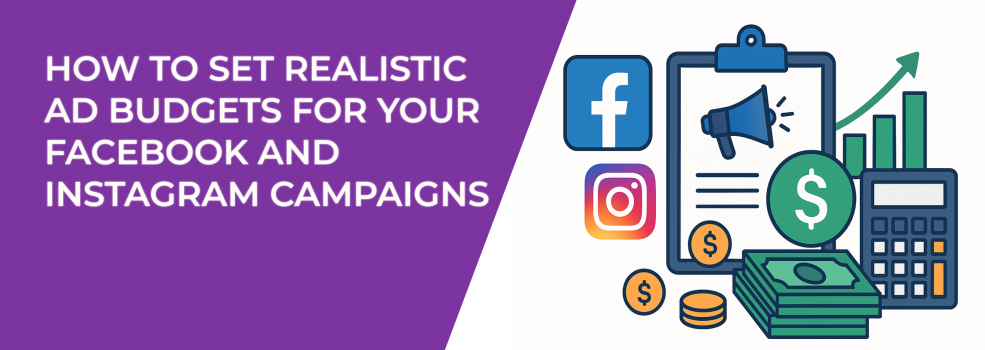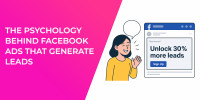There’s a big difference between spending on ads and investing in growth. And the line between the two? It’s called planning.
Facebook and Instagram ads can scale a small business or drain it. What makes the difference isn’t just creative quality or targeting — it’s how well your budget lines up with your actual objectives.
Let’s walk through how to create budgets that reflect your goals, adapt to real performance, and make each dollar work harder than the last.
Start with strategy, not spend
A common mistake among small business advertisers is opening up Ads Manager, plugging in a random number, and hoping the algorithm makes magic. The problem is, Meta’s platform doesn’t work like that anymore, and frankly, it never really did.
Before you ever set a budget, step back and ask what success looks like for this specific campaign. Are you introducing your brand to a new audience? Trying to re-engage warm leads? Pushing for direct sales?
Different goals require different levels of spend not just because the platform charges differently, but because each stage of the funnel demands a different type of interaction. A video view campaign costs less than a conversion campaign for good reason: one takes a tap, the other takes trust.
So start here: define your goal in one sentence. Then budget based on what it actually takes to reach it, not what’s left over after other expenses.
Not sure which objective best matches your goal? Check out Meta Ad Campaign Objectives Explained to break down which ones work for reach, engagement, leads, or sales.
A practical framework: budgeting by funnel stage
Not all campaigns are created equal. To avoid overspending in the wrong places (or under-funding the right ones), use this funnel-aligned approach to budget based on where your audience is in their journey.
1. Awareness campaigns (cold audiences)
If you’re targeting people who’ve never heard of your brand before, your job isn’t to sell — it’s to make a strong first impression. You’re paying for attention, not action. That attention is cheap, but it’s also fleeting. The goal is to stick in someone’s mind just enough that they recognize you when they see you again.
Start small — $10 to $20 per ad set per day can be enough to reach a sizable audience without wasting spend. But make sure your creative is built for the platform. Short-form video performs well here, as do bold visuals that stop the scroll.
Your success metrics? Look at impressions, video view percentages, and cost per 1,000 people reached (CPM). You’re not expecting purchases yet, and if you are, you're measuring the wrong thing.
The key here is volume and visibility. That’s what gives you a qualified pool for the next phase of the funnel.
2. Consideration campaigns (warm audiences)
Now you’re dealing with users who’ve interacted with your brand — maybe they visited your site, watched a video, or liked a post. They know you exist, but they’re not convinced. Your budget needs to support deeper engagement, not just broader reach.
Think of this phase as “make your case.” Use ads that demonstrate value: explainers, testimonials, product walkthroughs, or limited-time content that builds urgency.
Here, you’re typically spending $15 to $50 per ad set per day. That range gives you enough data to identify what’s working without rushing optimization. Your audiences are smaller, so you don’t need massive spend — but you do need consistent delivery so the algorithm learns who’s responding.
Watch for signals like landing page views, lead submissions, or longer video watches. These indicate rising intent. Don’t be afraid to test formats — carousels, lead forms, or interactive polls can all perform well here.
What matters most is aligning your message with their mindset: “You’ve seen us. Here’s why you should care.”
3. Conversion campaigns (hot audiences)
This is where you stop introducing and start converting.
When you're targeting people who’ve added items to their cart, visited product pages repeatedly, or subscribed to your emails, you're in the final stretch. This is where your budget has to match your ambition and your margins.
You can’t expect someone to buy just because you showed up. That last step is expensive, and the competition is high. These audiences are being targeted by other brands, too.
A good rule of thumb: spend enough to get at least 50 conversions per ad set per week if possible. This keeps Facebook’s optimization engine running smoothly. That might mean $25 to $100+ per day, depending on your average cost per purchase.
But don’t just throw money at it. Layer in smart tactics, like dynamic product ads, retargeting based on time-on-site, or creative with strong social proof.
Keep your offers clear, your creatives sharp, and your audience size tight.
If you're still refining your targeting setup, this guide on Facebook Ad Targeting 101 will help you structure high-performing audiences from the ground up.
Always budget for testing, not just performance
Too many advertisers spend their entire budget on what they think will work. But “what works” changes quickly.
That’s why you should always reserve 10–20% of your total ad budget for structured testing. This includes testing:
-
New ad creatives (images, videos, hooks);
-
Different audience segments;
-
Variations in copy or CTA;
-
Alternative landing pages or offers.
Treat this testing budget like R&D. It’s not wasteful — it’s foundational. Every future campaign depends on the insights you gain here.
And if something new outperforms your control ads? Shift more budget toward it. Quickly, but not blindly.
Building a balanced full-funnel budget
If you’re running multiple campaigns across different funnel stages, you need to allocate spend accordingly — not just based on results, but on role.
Think of it this way:
-
Top of Funnel (Awareness): Around 30–40%. This fuels audience growth;
-
Middle of Funnel (Consideration): Another 30–40%. This builds familiarity;
-
Bottom of Funnel (Conversion): The final 20–30%. This drives actual revenue.
Then carve out testing as a slice of each tier — not as an afterthought.
This kind of budget layering protects you from burnout and ensures you’re not trying to sell to people who don’t know you — or educating people who are ready to buy.
The timing question: how long should campaigns run?
Short, high-budget bursts can be useful for limited-time offers or product launches. But for most campaigns, a steady daily spend over a 7–14 day window gives you enough time to measure, learn, and adjust.
When thinking about campaign duration, remember to choose the type of budget (daily vs. lifetime) wisely.
Avoid switching budgets or making major edits during the first 3–4 days. This resets Meta’s learning phase and delays optimization. Give your ads space to breathe — then make data-driven changes once you have enough signals.
If your campaign is time-sensitive, front-load your budget. But if it's evergreen, focus on pacing and consistency.
Scaling without breaking things
Once something works, the next move is scaling. But it’s also where many campaigns go sideways.
Instead of doubling budgets overnight, increase spend gradually — around 15–20% every few days. This keeps the algorithm stable and your cost per result predictable.
Want to scale faster? Try duplicating a winning ad set and running it with a different audience segment or placement. Or reuse the same creative with a fresh hook or headline.
Scaling doesn’t just mean “more money.” It means “more reach without less return.”
For a more detailed breakdown, here’s how to scale Facebook campaigns without destroying performance.
Performance metrics that actually matter
Not all numbers are created equal. Focus on metrics that help you decide what to keep, cut, or scale.
Here are the ones that consistently reveal real performance:
-
Cost per result: are you paying more than your target? Why?;
-
Return on ad spend (ROAS): are you making more than you spend?;
-
Click-through rate (CTR): is your creative resonating?;
-
Frequency: are people seeing the same ad too often?;
-
Conversion rate: is your landing page doing its job?
Don’t react to every dip. But don’t ignore patterns. Data tells a story — read it before rewriting your budget.
Final word
There’s no universal “right” number for your ad budget — but there is a smart process for finding it.
Realistic budgets are born from clarity, not guesswork. Clarity about your audience, your goals, your margins, and your offer.
Use structure. Test ideas. Spend with intent. Reinvest in what works. And adjust quickly when things don’t.
Because in Facebook and Instagram advertising, being flexible beats being flashy — every single time.

